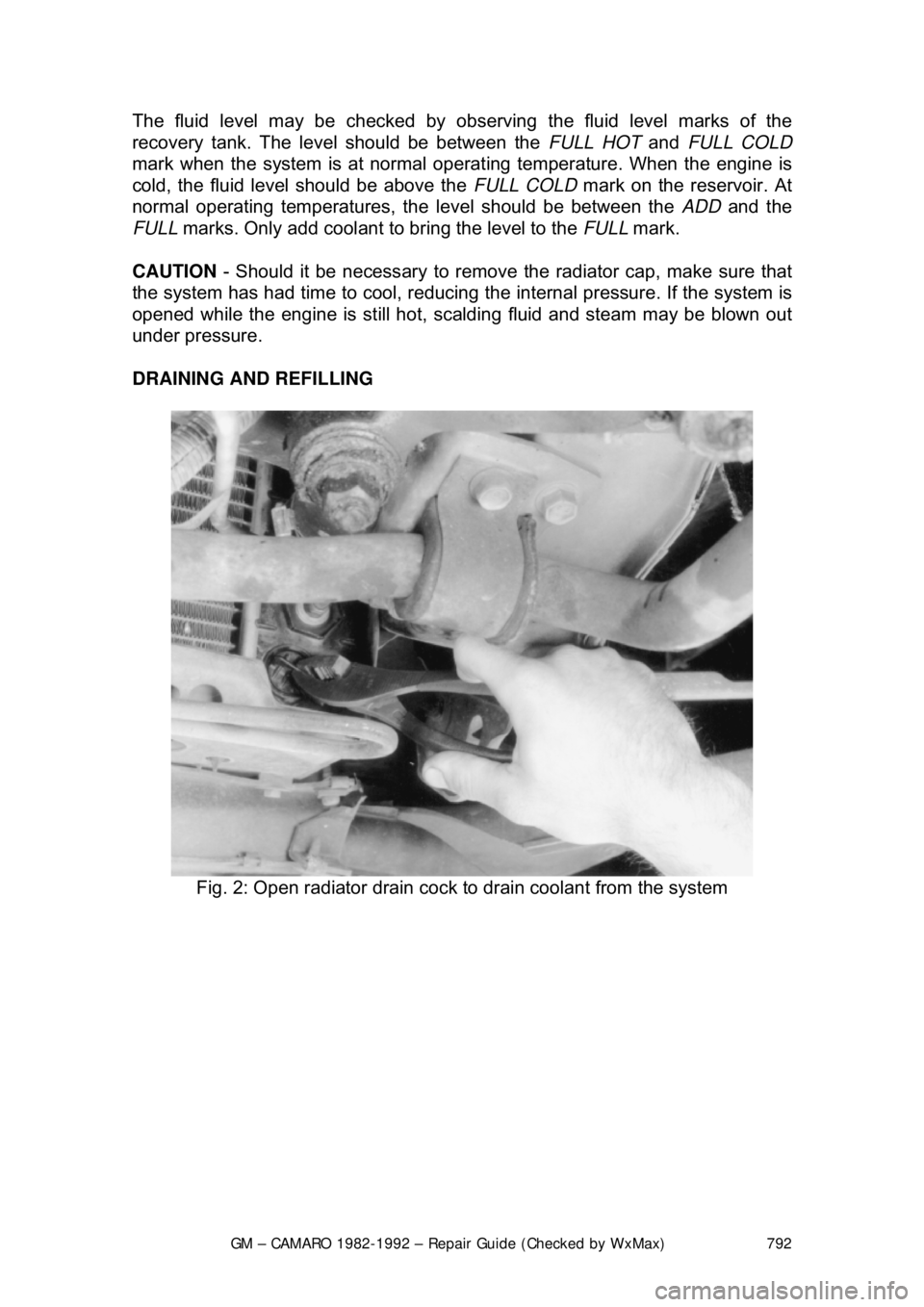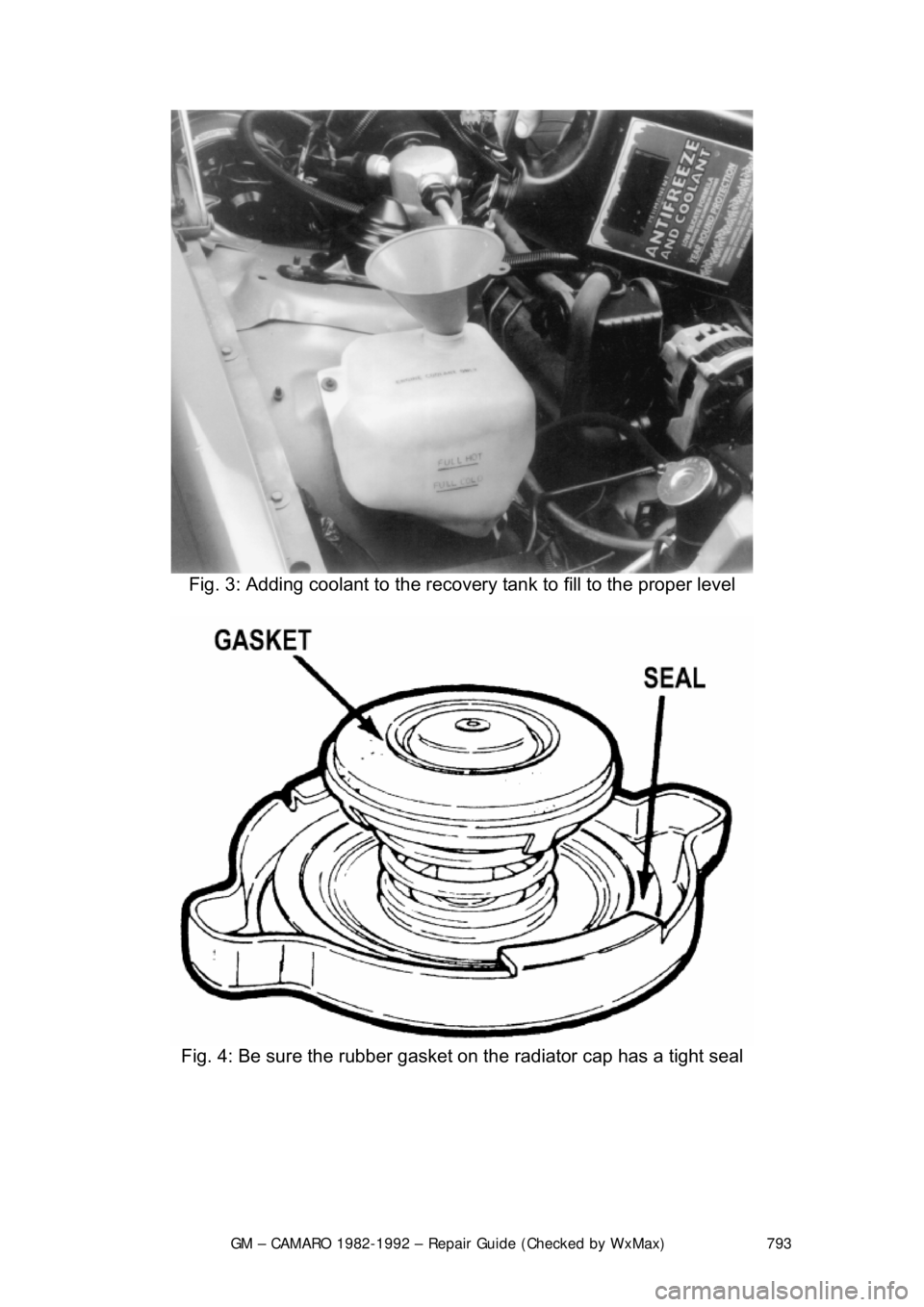1982 CHEVROLET CAMARO radiator cap
[x] Cancel search: radiator capPage 364 of 875

GM – CAMARO 1982-1992 – Repair Guide (Checked by WxMax) 364
5. Drain the radiator and remove t
he radiator hoses. Disconnect the heater
hoses and the transmission cooler lines.
6. Remove the upper half of the radi ator shroud, if equipped with a manual
transmission. Remove the radiator and fan shroud assembly, if equipped
with an automatic transmission.
7. Disconnect the throttle linkage, includi ng the cruise control detent cable.
8. Remove the air conditioning compressor and lay aside.
Do not disconnect the air conditioning lines.
9. Disconnect the power steering pump and drain the fluid into a suitable
container. Remove the vacuum brake booster line.
10. Remove the distributor cap and spark plug wires.
11. Disconnect the engine electrical connection at the bulkhead connection
and disconnect any necessary vacuum hoses.
12. Working inside the vehicle, re move the right-hand hush panel and
disconnect the ECM harness at the EC M. Raise and safely support the
vehicle. Remove the right fenderwell splash shield and feed the harness
through the fenderwell.
13. Disconnect the exhaust pipes at the exhaust manifolds and remove
exhaust system from the vehicle.
14. Remove the flywheel cover and remo ve the converter bolts, if equipped
with automatic transmission.
15. Disconnect the transmission an d starter wire connections.
16. Remove the bellhousing and t he motor mount through-bolts.
17. Disconnect the clutch fork return spring, if equipped with a manual
transmission. Lower the vehicle.
18. Relieve the fuel system pressu re. Disconnect the fuel lines.
19. Support the transmission with a suit able jack. Attach an engine lifting
device.
20. Remove the engine assembly.
To install: 21. Position the engine assembly in the vehicle.
22. Attach the motor mount to engine br ackets and lower the engine in place.
Remove the engine lifting device and the transmission jack.
23. Raise and support the vehicle safely.
24. Install the motor mount through-bolts and tighten the nuts to specification. Install t he bellhousing bolts and tight en to 35 ft. lbs. (47
Nm).
25. On vehicles with automatic transmissi on, install the converter to flywheel
attaching bolts to 46 ft. lbs. (63 Nm).
26. Install the flywheel splash shield and tighten to 89 inch lbs. (10 Nm).
Install the clutch return spring, if equipped with manual transmission.
27. Connect the starter wires and the fuel lines.
28. Install the exhaust system.
29. Lower the vehicle.
30. Install the power steering pump and the air conditioning compressor.
Page 365 of 875

GM – CAMARO 1982-1992 – Repair Guide (Checked by WxMax) 365
31. Connect the bulkhead harness connec
tor, wires and hoses. Reroute the
ECM harness in its original location. Install the hush panel and fenderwell
splash panel.
32. Install the radiator, fan and fan sh roud. Connect the radiator and heater
hoses, along with the transmission cooler lines.
33. Connect the vacuum brake booster li ne, the throttle linkage and cruise
control cable. Install the distributor cap.
34. Fill the cooling system with the proper type and amount of coolant and
the crankcase with the proper type of oil to the correct level.
35. Install the water pump drive bel t, the air cleaner duct and the hood.
36. Connect the negative battery cable, st art the engine and check for leaks.
2.8L AND 3.1L ENGINES
Fig. 2: Engine mountin g points for the V6
1. Disconnect the negative battery cable.
2. Remove the air cleaner duct.
3. Mark the hood location on the hood supports and remove the hood.
4. Remove the water pump drive belt.
5. Drain the radiator and remove t he radiator hoses. Disconnect the heater
hoses and the transmission cooler lines.
6. Remove the fan shroud, fan and radiator.
7. Disconnect the throttle linkage, includi ng the cruise control detent cable.
Page 366 of 875

GM – CAMARO 1982-1992 – Repair Guide (Checked by WxMax) 366
8. Remove the air conditioning co
mpressor and lay aside. Remove the
power steering pump and lay aside.
Do not disconnect the air conditioning or power steering lines.
9. Remove the vacuum brake booster line.
10. Remove the distributor cap and spark plug wires.
11. Disconnect the necessary elec trical connections and hoses.
12. Raise and safely support the vehicle.
13. Disconnect the exhaust pipes at the exhaust manifolds.
14. Remove the flywheel cover and remove the converter bolts.
15. Disconnect the star ter wire connections.
16. Remove the bellhousing and t he motor mount through-bolts.
17. Lower the vehicle.
18. Relieve the fuel system pressu re. Disconnect the fuel lines.
19. Support the transmission with a suit able jack. Attach an engine lifting
device.
20. Remove the engine assembly.
To install: 21. Position the engine assembly in the vehicle.
22. Attach the motor mount to engine br ackets and lower the engine in place.
Remove the engine lifting device and the transmission jack.
23. Raise and support the vehicle safely.
24. Install the motor mount through-bolts and tighten the nuts to 50 ft. lbs. (68 Nm). Install the bellhousing bolts and tighten to 35 ft. lbs. (47 Nm).
25. On vehicles with automatic transmissi on, install the converter to flywheel
attaching bolts to 46 ft. lbs. (63 Nm).
26. Install the flywheel splash shield and tighten to 89 inch lbs. (10 Nm).
27. Connect the starter wires and the fuel lines.
28. Install the exhaust pipe on the exhaust manifold.
29. Lower the vehicle.
30. Install the power steering pump and the air conditioning compressor.
31. Connect the necessary wires and hoses.
32. Install the radiator, fan and fan sh roud. Connect the radiator and heater
hoses and the transmission cooler lines.
33. Connect the vacuum brake booster li ne, the throttle linkage and cruise
control cable. Install the distributor cap.
34. Fill the cooling system with the proper type and amount of coolant and
the crankcase with the proper type of oil to the correct level.
35. Install the water pump drive bel t, the air cleaner duct and the hood.
36. Connect the negative battery cable, st art the engine and check for leaks.
Page 386 of 875

GM – CAMARO 1982-1992 – Repair Guide (Checked by WxMax) 386
FUEL INJECTION
1. Remove the air cleaner.
2. Drain the radiator.
3. Disconnect: a. Battery cables at the battery.
b. Upper radiator and heater hoses at the manifold.
c. Crankcase ventilation hoses as required.
d. Fuel line at the carburetor.
e. Accelerator linkage.
f. Vacuum hose at the distributor, if equipped.
g. Power brake hose at the car buretor base or manifold, if
applicable.
h. Temperature sending switch wires.
4. Remove the distributor cap and scribe the rotor position relative to the
distributor body, and engine.
5. Remove the distributor.
6. If applicable, remove the alternator upper bracket. As required, remove
the air cleaner bracket, and accelerator bellcrank.
7. Remove the manifold-to-head attachi ng bolts, then remove the manifold
and carburetor as an assembly.
8. Mark and disconnect all emission re lated items (e.g.: wiring, vacuum
hoses, etc.) which are connected to manifold mounted items.
9. If the manifold is to be replaced , transfer the carburetor (and mounting
studs), water outlet and thermostat (use a new gasket) heater hose
adapter, EGR valve (use new gasket) and, if applicable, TVS switch(s)
and the choke coil.
To install: 10. Before installing the manifold, thoroughly clean the gasket and sealing
surfaces of the cylinder heads and manifold.
11. Install the manifold end seals, folding the tabs if applicable, and the
manifold/head gaskets, using a s ealing compound around the water
passages.
Make sure that the new manifold gaskets match the old ones EXACTLY.
12. When installing the manifold, care should be taken not to dislocate the
end seals. It is helpful to use a pilo t in the distributor opening. Tighten the
manifold bolts to 30 ft. lbs. (40 Nm) for 5.0L or 20-25 ft. lbs. (27-34 Nm)
for 2.8L in the sequence illustrated.
13. Install the distributor with the rotor in its original location as indicated by
the scribe line. If the engi ne has been disturbed, refer to the previous
Distributor Removal and Installation procedure.
14. If applicable, install the alter nator upper bracket and adjust the belt
tension.
15. Connect all disconnected components at their original locations.
16. Fill the cooling system, start the engine, check for leaks and adjust the
ignition timing and carburetor idle speed and mixture.
Page 391 of 875

GM – CAMARO 1982-1992 – Repair Guide (Checked by WxMax) 391
8. Remove the plenum attaching bolts and plenum. Discard the gaskets.
9. Remove the fuel rail.
10. Label and unplug the wires
from the spark plugs.
11. Label and unplug the wires at the coil.
12. Remove the distributor cap and spark plug wires.
13. Mark the distributor position and remove it.
14. Label and disconnect the emission canister hoses.
15. Remove the valve covers.
16. Remove the upper radiator hose at the manifold.
17. Unplug the coolant switch and sensor.
18. Remove the heater inlet pipe from the manifold.
19. Remove the center intake manifold bolts.
20. Remove the center intake mani fold and gasket. Discard the gasket.
21. Remove the transmission dipstick.
22. Remove the manifold bolts.
23. Remove the manifold. Discard t he gaskets and remove the RTV sealant
from the front and rear ridges of the block.
To install: 24. Apply a
3/16 in. (5mm) bead of RTV sealant on the front and rear ridges of
the block. Make sure the surfaces are clean.
25. Install the new gaskets on the cylinder heads. Hold the gaskets in place by extending the RTV bead up onto t he gasket ends. Certain GM intake
gaskets will have to be cut to be install behind the pushrods. Cut these
gaskets as required and only where necessary.
26. Install the intake m anifold along with the intake manifold bolts. Torque
bolts in sequence to 13-25 ft. lbs. ( 18-34 Nm) on 2.8L engines and 19 ft
lbs. (26 Nm) on 3.1L engines.
27. Install the center intake manifold with a new gasket. Tighten the bolts to
15 ft lbs. (21 Nm).
28. Connect the coolant switches.
29. Install the upper radiator hose.
30. Install the valve covers.
31. Install the heater inlet pipe.
32. Connect the emission canister hoses.
33. Install the distributor to the matc hmarks, hold down bolt, spark plug wires
and distributor cap.
34. Install the spark plug wires to th e spark plugs and connect the wires at
the coil.
35. Install the fuel rail.
36. Install the plenum with new gaskets . Tighten the bolts to 18 ft lbs. (25
Nm) on 2.8L engines or 15 ft lbs. (21 Nm) on 3.1L engines.
37. Install the A/C compressor-to-plenum bracket and attaching hardware.
38. Install the EGR transfer tube with a new gasket. Tighten the bolts to 19 ft
lbs. (26 Nm).
39. Install the throttle body.
40. Connect the vacuum harness and ai r inlet duct to the throttle body.
41. Install the transmission dipstick.
42. Connect and other rema ining hoses or wires.
Page 393 of 875

GM – CAMARO 1982-1992 – Repair Guide (Checked by WxMax) 393
8. Label and unplug the spark
plug wires at the cap.
9. Mark the distributor position and remove it.
10. Unplug the injector wiring harness.
11. Remove the left side runner-to-plenum bolts.
12. Remove the left side runner-to-manifold bolts.
13. Remove the right side runner-to-plenum bolts.
14. Remove the right side runner-to-manifold bolts.
15. Remove the EGR solenoid, if necessary.
16. Remove the right side manifold-to-runner bolt.
17. Remove the plenum, right side runners and gaskets. Discard the gaskets.
18. Remove the left side manifold-to-runner bolt.
19. Remove the left side runners and gaskets. Discard the gaskets.
20. Disconnect the upper radiator hos e from the thermostat housing.
21. Remove the EGR valve, if necessary.
22. Unplug any other electrical or hose connections, as necessary.
23. Remove the intake manifold bolts.
24. Remove the intake manifold and gaskets. Discard the gaskets.
To install: 25. Apply a
3/16 in. (5mm) bead of RTV sealant on the front and rear ridges of
the block. Make sure the surfaces are clean.
26. Install the new gaskets on the cylinder heads. Hold the gaskets in place by extending the RTV bead up onto the gasket ends.
27. Install the intake manifold.
Sealing of the intake mani fold to the "V" of the engine is obtained by employing
an intermediate torque specification to a ll the attaching bolts, alternately, in the
proper sequence. This step is used to rock the manifold into place before
applying the final torque figur e. Failure to follow this two-step procedure can
result in possible leaks.
28. Install the intake manifold attach ing bolts. Tighten them, using the proper
sequence, to 89 in lbs. (10 Nm).
29. Final torque the bolts, using the proper sequence, to 35 ft lbs. (47 Nm\
).
30. Install the EGR valve using a new gasket.
31. Connect the upper radiator hose to the thermostat housing.
32. Install new gaskets on the runner s and intake manifold. Make sure the
gasket sealing surfaces are clean.
33. Install the left side runners and finger-tighten the runner-to-manifold
bolts.
34. Install the left side manifold-to-runner bolt. Torque to 25 ft lbs. (34 Nm).
35. Install the right side runners. Fi nger-tighten the runner-to-manifold and
manifold-to-runner bolts.
36. Install the plenum and t he runner-to-plenum bolts.
37. Tighten the runner-to-manifold bolts to 25 ft lbs. (34 Nm). Start in the
center and work outwards.
38. Tighten the right side manifold-to -runner bolt to 25 ft lbs. (34 Nm).
Page 792 of 875

GM – CAMARO 1982-1992 – Repair Guide (Checked by WxMax) 792
The fluid level may be checked by obs
erving the fluid level marks of the
recovery tank. The leve l should be between the FULL HOT and FULL COLD
mark when the system is at normal operat ing temperature. When the engine is
cold, the fluid level should be above the FULL COLD mark on the reservoir. At
normal operating temperatures, t he level should be between the ADD and the
FULL marks. Only add coolant to bring the level to the FULL mark.
CAUTION - Should it be necessary to remove the radiator cap, make sure that
the system has had time to cool, reducing t he internal pressure. If the system is
opened while the engine is st ill hot, scalding fluid and steam may be blown out
under pressure.
DRAINING AND REFILLING
Fig. 2: Open radiator drain cock to drain coolant from the system
Page 793 of 875

GM – CAMARO 1982-1992 – Repair Guide (Checked by WxMax) 793
Fig. 3: Adding coolant to the recove ry tank to fill to the proper level
Fig. 4: Be sure the rubber gasket on the radiator cap has a tight seal